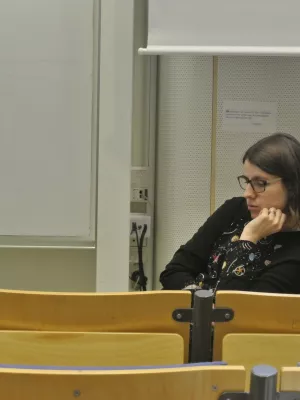
Sanna Alwmark
Postdoc

Resolving the age of the Puchezh-Katunki impact structure (Russia) against alteration and inherited 40Ar* – No link with extinctions
Författare
Summary, in English
The possibility of a “death from above” cause for biotic crises and extinction events is intriguing, to say the least, but such claims must be supported by reliable and reproducible data, not only impact diagnostic criteria, but also accurate and precise radioisotopic ages of the impact structures/events. To date, only one example of such an impact-related global extinction event is confirmed, at the end of the Cretaceous period. Here we present and discuss results of newly obtained 40Ar/39Ar data from step heating analysis of impact melt rock samples from the 40 km-in-diameter Puchezh-Katunki impact structure, Russia, which allow us to precisely and accurately date its formation at 195.9 ± 1.0 Ma (2σ; P = 0.10). Based on these new data, we challenge the proposed temporal correlation with as many as five different extinction events (including the end-Triassic mass extinction) that were based on previous age estimations ranging from ∼164 to 203 Ma. Our new age for the formation of the Puchezh-Katunki impact structure allows us to exclude a relationship between this impact event and a known extinction event. We also show that careful sample preparation and methodology can overcome problems with inherited and trapped 40Ar, issues that are common when dating impact melt rocks. This is supported by 40Ar* diffusion and mixing numerical models showing that the most prominent negative effects in the case of the Puchezh-Katunki impact melt rock samples are caused by hydrothermal alteration and undegassed melt rock domains present in an otherwise homogenized melt rock. Numerical modeling also shows that the 40Ar* from high-Ca inherited crystals or clasts is decoupled from the melt rock during step heating experiments allowing to safely recover a plateau age. Finally, our results highlight the importance of improving the database of ages of impact structures and show that caution should be practiced when suggesting connections between specific impact events and extinction events, especially in the case of poorly dated impact structures.
Avdelning/ar
- Berggrundsgeologi
Publiceringsår
2021
Språk
Engelska
Sidor
116-140
Publikation/Tidskrift/Serie
Geochimica et Cosmochimica Acta
Volym
301
Dokumenttyp
Artikel i tidskrift
Förlag
Elsevier
Ämne
- Geology
Nyckelord
- 40Ar/39Ar dating
- Extinction events
- Impact crater
- Inherited 40Ar*
- Puchezh-Katunki
Status
Published
ISBN/ISSN/Övrigt
- ISSN: 0016-7037

